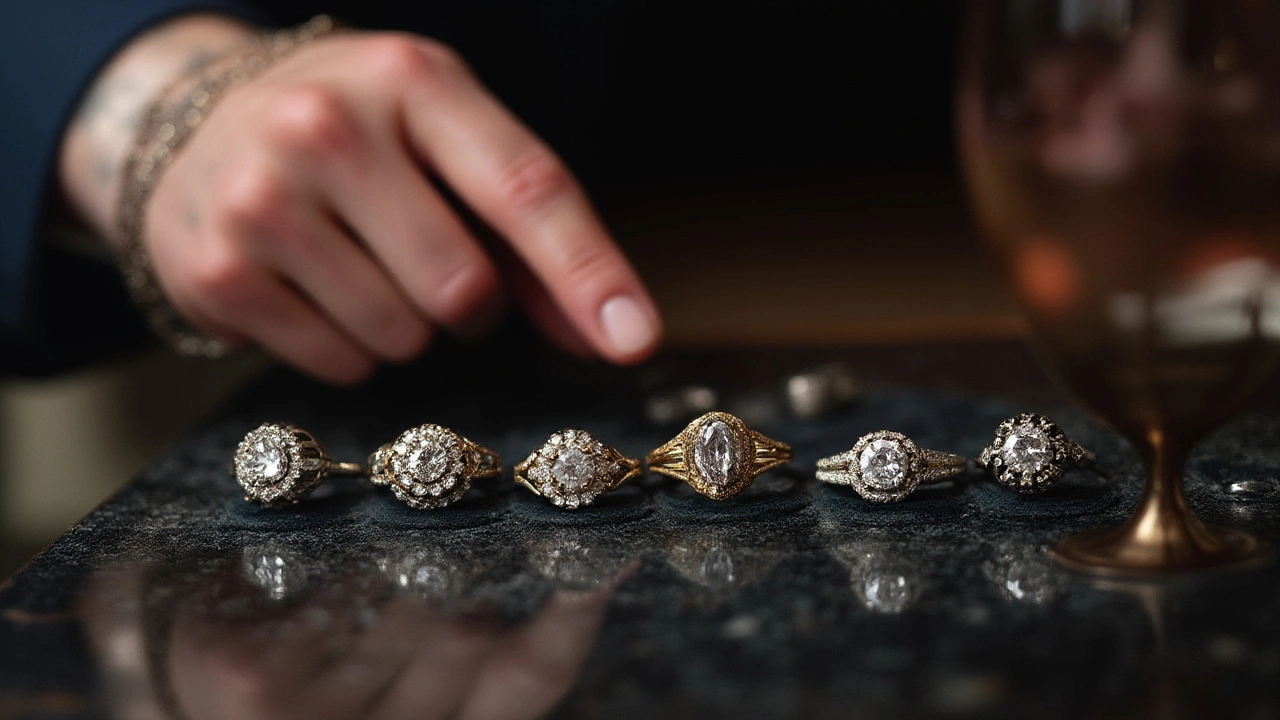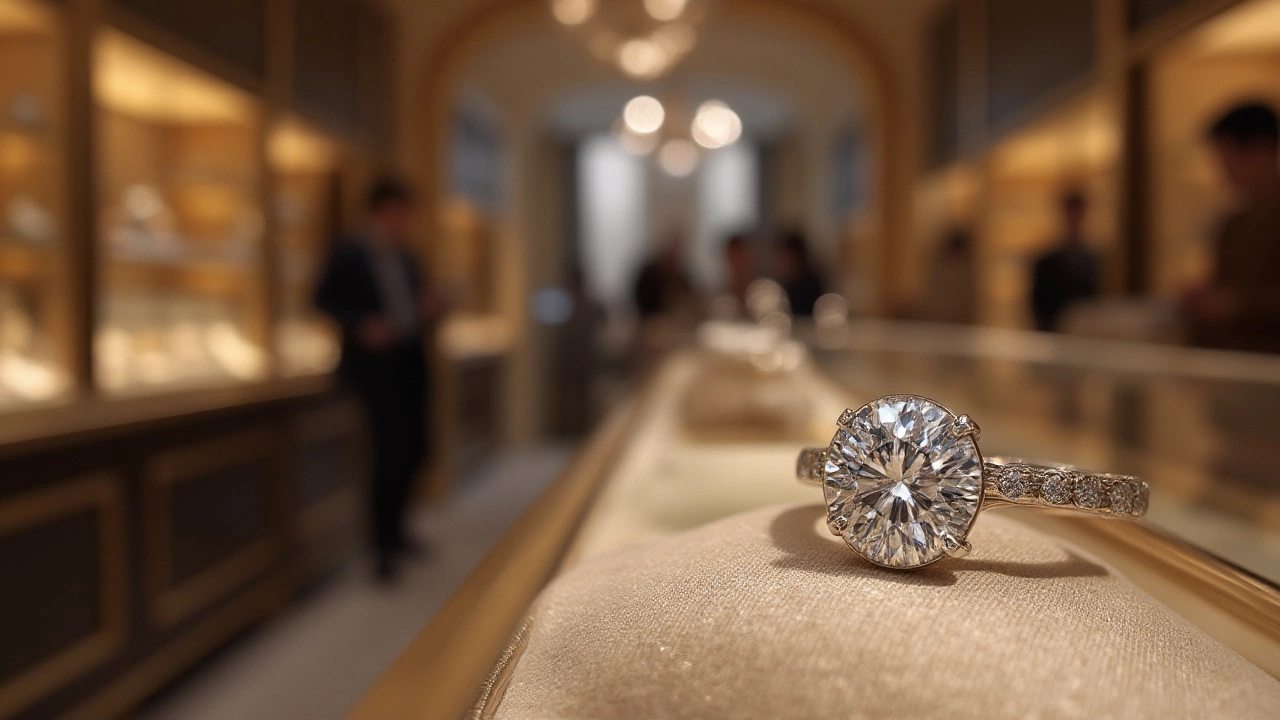Picture this: you slide a ring onto your finger, and it glimmers enough to catch the corner of your eye every time you move. For a lot of couples staring at that $10,000 price tag, the question that stings hardest isn’t just “Can I afford this?” but “What exactly do I get for ten grand?” Spoiler: it’s not all about rock size. But don’t worry, you’re not the only one who’s wondered how big a $10,000 ring really is—and whether it lives up to the movie magic. There’s a surprising amount that goes into the answer, from carat math to setting choices to the not-so-sexy stuff, like GIA certificates and what metal you pick. So if you want to get the most sparkle per dollar, or you’re worried your ten thousand bucks will leave you empty-handed or disappointed, here’s what you need to know, straight up (and no, the answer isn’t always clear-cut).
What Does $10,000 Get You? The Numbers Behind the Price
When people start ring shopping, there’s one thing everyone wants to know: how big of a diamond can I get for $10,000? It’s tempting to think all $10,000 rings come with a massive stone, but diamond prices are anything but straightforward. The biggest chunk of your cash goes toward the four Cs (carat, color, clarity, and cut)—and they all push and pull against each other in the final price tag.
As of this year, a $10,000 budget puts you in a sweet spot. You’re not quite in the “celebrity engagement” category, but you’re definitely ahead of the national average. According to data from The Knot’s 2024 Jewelry & Engagement Study, the average engagement ring in the U.S. costs around $6,000. So, your $10,000 budget is on the high end for most buyers, and plenty to snag a quality diamond of noticeable size.
But the carat game isn’t as simple as it sounds. Here’s a breakdown of what you might expect for your budget, focusing on a classic round brilliant-cut diamond (prices vary for other shapes):
| Carat Weight | Color (G-H) | Clarity (VS2-SI1) | Average Price (2025) |
|---|---|---|---|
| 1.2 - 1.4 | G-H | VS2-SI1 | $8,800 - $10,200 |
| 1.0 | D-F | VVS2 | $9,200 - $10,000 |
| 1.5 | K-L | SI2 | $9,000 - $10,000 |
This table shows that the size depends not just on carat, but also on how picky you get about color and clarity. Want ultra-clear and colorless? You might only get about a 1.0 carat stone. Willing to drop down a bit in color or clarity? You could creep up to 1.5 carats, but the diamond may show some inclusions or a yellowish tint. Cut also matters—a well-cut 1.2 carat sparkles way more than a poorly cut 1.5.
It’s not just about the numbers, though. Diamonds come in all shapes—round, oval, pear, emerald, cushion, marquise. Fancy shapes (which means anything not round) can actually cost less per carat, so you may score a larger-looking stone for the same money. For example, an oval cut looks bigger for the same weight, thanks to its elongated silhouette. The gold or platinum that holds the stone can nibble 10–20% off your budget depending on the style. So, if you see a $10,000 diamond ring that blows your mind on Instagram, check the details before your heart sets itself on an impossible standard.
What Impacts Size? Cut, Carat, and Illusions
The carat isn’t the whole story when it comes to how big a $10,000 ring looks on your hand. The cut plays a huge part—and not just in how it sparkles. Take two 1.2 carat diamonds: a perfectly cut one might look larger than a badly cut 1.5. Cut determines how much light the diamond throws back at your eyes and how big the stone actually appears when viewed from above (the face-up appearance).
Then there are optical tricks. Certain ring settings can make the center stone look as much as 30% bigger. Do you pick a halo? You’ll surround the central diamond with smaller stones, giving the illusion of a much larger ring—think of it as a frame that makes the picture pop. Thin bands make your diamond look bigger relative to your finger. On the flip side, chunky or ornate bands, or a high-profile setting, can make the stone seem smaller.
Diamond shape is one of the best ‘hacks’ for looking like you got more diamond for your dollar. Ovals and marquise cuts look larger due to their surface area. Pear shapes, too. Square shapes like cushions and princess cuts are a little more compact, but still often cheaper per carat than round. So you could get, say, a 1.4 carat oval for the price of a 1.2 round—and most people will think the oval looks huge by comparison.
Don’t overlook finger size either: the same diamond looks giant on slimmer fingers and daintier on larger hands. Even your ring size changes the vibe. Pro tip: Try on different diamonds in-store rather than just browsing online. What pops in the box can look totally different in real life. Jewelers are used to people doing the ‘hand test’—there’s absolutely no shame.
Many jewelers set side stones or diamond accents along the band to add extra bling. These don’t dramatically increase cost, but help the ring shine bigger than its center stone. Milgrain details (tiny metal beads along the edge), split shanks, or twisting bands all eye-trick your brain into seeing “more ring” for the price.

Comparing Ring Styles: Solitaire, Halo, Vintage and Modern
So, what does a $10,000 ring actually look like on your finger? Here’s where style steps in. Modern buyers have endless options. Will you go classic and understated, or bold and bedazzled? Let’s break down a few typical routes people take with this kind of budget.
- Solitaire: This style features a single stone, usually round or oval. For $10,000, you can get a clean band (gold or platinum) with a diamond between 1 and 1.4 carats of high color and clarity. Solitaire rings make the diamond the star, and are timeless—but all eyes land on the stone itself, so imperfections or smaller carat sizes are more obvious.
- Halo: Halos are queens of visual illusion. A 1 carat center with a halo of tiny diamonds can look like a 1.5 or even 2 carat ring for a much lower price. Your $10,000 can stretch to a 1.2 carat center stone with a dazzling frame plus a sparkly diamond band—that’s a lot of bling for the buck.
- Three-Stone: These rings showcase a center diamond flanked by two smaller ones. For the “classic Meghan Markle effect,” you’ll get something around a 1.0–1.2 carat center, with side stones about a third of the size. It’s a balanced, vintage-inspired look that maximizes finger coverage without maxing out your budget on one big rock.
- Vintage: Love Art Deco or Victorian styles? Even with antique settings and intricate details (filigree, hand engraving), a $10,000 spend will get you a slightly smaller center—closer to 1 carat—but a richly detailed, truly unique ring. Sapphire or emerald side accents can make it even more personal.
- Custom: Want your ring to tell your story? Custom work eats into the budget, but can let you prioritize what matters. Maybe you want a larger but slightly lower-grade stone styled in an intricate setting, or a mix of metals and gems to create something new. A trend in 2025: lab-grown diamonds. They’re indistinguishable from natural ones and can run 30–50% less, pushing your budget into 2-carat territory if you’re open to it.
Don’t forget to budget for extras: certifications (like GIA), insurance, resizing, and maintenance. These all matter, especially if you want your ring to shine for life and hold its value.
Shopping Tips: How to Get the Most Out of Your $10,000
There’s a wild world of sparkle out there, and if you’re dropping $10,000, you deserve a ring that matches your style and your expectations. Here’s how to get the best deal (and peace of mind):
- Know the four Cs, but know which matter most to you. If you or your partner want a big look, prioritize carat and cut over color and clarity. If sparkle and perfection drive you, cut and clarity are king.
- Shop around, online and in person. Physical stores let you try on rings, but online retailers often offer better prices and a huge selection. Just make sure any diamond comes certified by a reputable lab (GIA is the gold standard).
- Consider going just under popular weights—like 0.97 instead of 1.0 carat. You’ll save hundreds, sometimes thousands, and the difference is invisible to the naked eye.
- Traditional diamonds are great, but don’t gloss over lab-created stones. In 2025, lab diamonds look identical to the real thing, come certified, and cost half as much. That means double the sparkle for your spend, or a major upgrade in size or quality.
- Ring metal matters. Platinum costs more than gold, and rose gold is often the most budget-friendly. Your style—modern, classic, or vintage—should guide you, but saving on metal could mean more for your center stone.
- Always budget for extras. Insurance is a must. Most policies cost 1–2% of the ring’s value per year. Resizing (especially if the proposal’s a surprise) can cost $100–$300. Cleaning and maintenance keep your ring shining forever.
So, how big is a $10,000 ring? With smart choices, you’re looking at a diamond around 1.2 carats, possibly bigger with fancy shapes or lab-grown stones, set in a style that fits your taste and your lifestyle. It’s enough to make a bold statement, but not so huge you’ll feel awkward wearing it every day. And isn’t that what most of us want? Something impressive, meaningful, and built to last—not just a number on a price tag but a real piece of your story.
